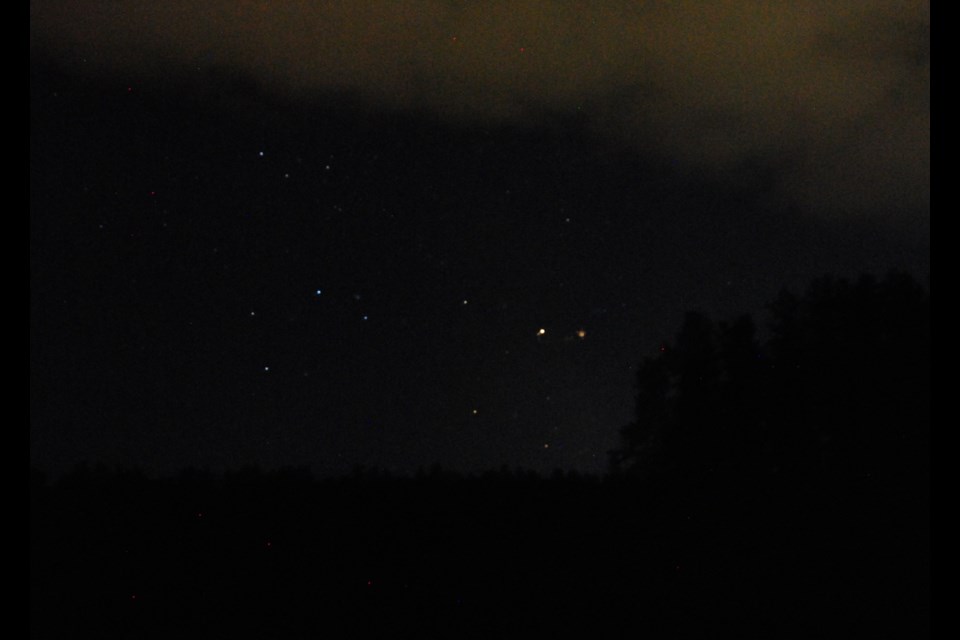Seventy avid, and some neophyte stargazers, gathered on the shores of Hersey Lake, just north of Timmins, off of Highway 655, just before sunset, to stare at the night sky and see what they could see in the heavens above.
The Science Timmins Astronomy Club held its first ever “Star Party” on Saturday from 7 to 11 p.m. at Hersey Lake.
The event was billed as an all age’s event and was part of Timmins’ celebration of Culture Days and also Astronomy Month at the Timmins’ Science Village.
There was a campfire on-site, but stargazers were asked to please dress warmly and bring a chair or ground cover to make themselves and their families comfortable.
Saturday was also "Astronomy Day" at the Science Village running from 10 a.m. to 4 p.m. (approx.)
“Science Timmins has taken part in Culture Days since the first one in 2013,” said Karina Douglas-Takayesu, reference librarian with Timmins Public Library and also one of the two Culture Days Taskforce members.
“Last year was perfect for the Astronomy Club as Culture Days, coincided with a total lunar eclipse and we tried to get everybody out here to watch it.” Douglas-Takayesu recalled.
This Saturday the sky was mainly cloudy with two bands of clear sky to the north and the other to the south west.
Earlier in the evening Louis-Pierre Sauvé, the President of the Timmins Astronomy Club and some of his friends set up telescopes along the north shore of Hersey Lake.
About three hundred metres to the west, a volunteer had built up a hardy fire for roasting S’mores and other edible objects.
For those in attendance who wanted a hardier fare, volunteers had also brought along sandwiches and baked goodies that were placed on a nearby picnic table.
Douglas-Takayesu tried to identify some of the few stars visible and see if they comprised a recognizable constellation.
With the limited patches of sky it was difficult to pinpoint constellations, but one bright object was clearly identifiable to Douglas-Takayesu.
“That bright object in the southwest sky is the planet Saturn,” she said with certainty.
In addition to Saturn the big buzz of the night was that the International Space Station was scheduled to be flying overhead way above Timmins at 9:18 p.m.
“Many astronomy club members are tracking the movement of the ISS on their cell phone app,” said Douglas- Takayesu. “The space station orbits the earth every 90 minutes, but it doesn’t always fly directly above Timmins.”
At first people pointed to a rather wobbly moving light that traversed the sky from west to east and believed that was the ISS, but that turned out to be a satellite.
“That’s not the ISS,” someone shouted in the dark. “The space station is over there.”
Sure enough the much brighter, more defined path of the celestial object also traveling from west to east proved without a doubt that this indeed was the real space station.
Please click here to get the app that allows you to track the space station.
Douglas-Takayesu said the link between culture and astronomy can be seen through connection with Greek mythology and the mythology of other cultures in name stars and constellations.
“In Japan there is a constellation called Subaru or the seven sisters,” she explained. “The Subaru car company takes its name from that constellation and its logo has the seven stars.”
The crowd blurted out a collective “Ohhh!”
“It’s a meteor,” Douglas-Takayesu pointed out. “But you have to be very fast to see it.”
Another unusual fact about the night sky was that there was no moon visible.
“Last night we experienced what is known as a black moon,” said Douglas-Takayesu. “That’s when two new moons occur in one month – the second one is called a black moon.”
Louis-Pierre Sauvé, retired teacher at École secondaire catholique Thériault, pointed out a couple of constellations as the overhead sky cleared around 9:30 p.m.
“Those stars over head, they form a square that is the constellation Pegasus,” Sauvé said.
Sauvé also pointed out the constellation Andromeda.
Despite the partly cloudy skies overhead for much of the night, Douglas-Takayesu hoped that the experience would encourage new members to come out and join the Timmins Astronomy Club which meets the third Wednesday of each month at the Timmins Science Village at 7 p.m.
“This is also part of Astronomy Day the Science Village and the kickoff of October as Astronomy month,” explained Douglas-Takayesu.
For more information:
http://www.sciencetimmins.com/programs/outreach-programs/astronomy-club/



